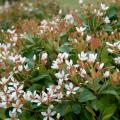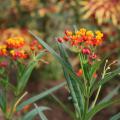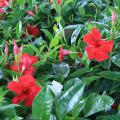Southern Gardening from 2012
In my job with Mississippi State University, I am asked a lot of questions about problems people have with plants and ideas they have for their landscapes and gardens.
As we begin the new year, here is my list of four resolutions to help make your landscape and garden more enjoyable and productive in 2012.
1- Get those pesky landscape and lawn weeds under control.
Of all of our activities, wedding ceremonies may be the most symbolic. Symbolism is found in everything from the rings, representing the couple’s commitment of everlasting love, to who sits on which side of the church. Even the flowers used in ceremonies can be symbolic.
When choosing wedding flowers, the most important consideration may be the colors of the bride’s and bridesmaids’ dresses, but you should also consider the symbolic meaning of the flower. You certainly don’t want to convey the wrong message on your wedding day.
These are classic symptoms of gardening cabin fever. For the active gardener, it only gets worse when all those catalogs start arriving.
If you’re still looking for a fantastic indoor plant for the winter season, try cyclamen. It has a long blooming period and produces loads of colorful flowers to enjoy on dreary days.
Flowers can be found in a variety of shades of red, pink and white, but I think some of the most attractive are the soft pastels of pink and lavender.
The nodding flowers have swept-back petals that are held on straight stems above the foliage. Another highly attractive feature of cyclamen is that they have varying patterns of silver and gray on the cordate, or heart-shaped, leaves.
Gardeners seeking color for the winter landscape should look beyond traditional pansies and violas and embrace the wide range of ornamental vegetables that can be grown in Mississippi. I’ve written about the colorful varieties of ornamental kale and cabbage, but a plant that doesn’t get much press is Swiss chard. Swiss chard is a winter annual available in a variety of bright and eye-catching colors, and it will certainly attract attention if you grow it.
Purple coneflowers are a flowering Mississippi native perennial that can really make a statement in your home garden and landscape.
The plant’s name comes from the beautiful purple flowers that seem to attract an endless number of butterflies and bees, especially all sorts of bumblebees. Traditionally, flower colors range from pastel purplish-pinks to deep, dark, vibrant burgundies.
If you’re like me and constantly looking for true blue flowers, you will want to be sure to make a place in your garden for the blue butterfly plant.
I enjoy spring, when greenhouses and garden centers start offering all sorts of new and exciting plants for our Mississippi landscapes and gardens. I’m always on the lookout for blue flowers to include in the landscape.
Like every gardener in Mississippi, I get spring fever this time of year. Seed catalogs are piling up higher every day. When visiting garden centers, I’m tempted by the racks of vegetable transplants available. I’ve even seen tomatoes on a warmer weekend. What’s a gardener to do?
To help hold us over until spring really arrives, African daisies and Senetti pericallis are perfect additions for landscape color. Both like the cooler early spring temperatures and can be used exactly like the mums we used last fall.
As springtime arrives across Mississippi, azaleas are starting to put on their colorful show. While these walls of pink and clusters of red and spots of white are well-known and anticipated, a spring-blooming shrub that does not get as much attention is the Indian hawthorn.
As gardeners look forward to the spring planting season, many go in droves to the various garden shows and displays to see some of the newest and flashiest flowers on the market. This weekend at the Gulf Coast Garden & Patio Show was no exception.
Mississippi gardeners got the chance to see the new Mississippi Medallion-winning plants for 2012. This year’s flowering plant winner is Vista Bubblegum supertunia. The flowers are a clear, bright pink and have performed well in Mississippi gardens the past few years.
If there’s a single shrub that could be called a staple in the Southern landscape, it has to be the azalea. Its spectacular flowering has made the azalea one of the all-time most popular landscape shrubs.
Here on the coast, azaleas have been putting on a show since they began blooming in early March. The progression of blooms will continue to north Mississippi by early April. One of the earliest-blooming varieties is the Southern Indica azalea. Whether used as specimen plants, hedges or backgrounds, the Southern Indica has to be my favorite azalea.
Every spring, I look forward to seeing wisterias bloom. It’s incredible how high these vines can climb into trees. They are a familiar sight along roadsides, and I really enjoy the 55-mile-per-hour flower show I get as I drive along the highways in Mississippi.
In this setting, these vigorous and aggressive vines seem to be out of reach for the ordinary home landscape. But wisteria vines can actually be used in a more confined space, assuming you are committed to keeping the vine in place through training and pruning.
Home gardeners show a growing interest in using native plants in the landscape, as these have a high tolerance for local environmental conditions. While they have a better chance of survival, they are sometimes limited in their ability to create excitement in the landscape.
I want to introduce you to some native plants that have no problem adding pizazz to a landscape. Two you should consider are butterfly weed and Virginia sweetspire. Both have been named Mississippi Medallion winners for their superior garden and landscape performance.
I think every gardener should take advantage of verbena, a plant that provides three seasons of color.
Verbena is a great flowering plant and belongs to a group of versatile plants that have been proven garden staples for years.
One of verbena’s best attributes is its flowering potential. These plants provide abundant color starting in the early spring and continuing right through the fall. If you protect them from frosts, you can extend their flowering well into late fall. Verbena also attracts butterflies all flowering season.
If you’re thinking about what you want your porch or deck to look like this summer, consider how you can use Mandevilla, a vining plant best known for its showy displays of summertime flowers.
You can find these plants in red, pink and white at garden centers. Flowers are displayed against a backdrop of dark green, leathery foliage. Leaves can be quite large -- up to 8 inches long. Some selections have smaller leaves. The plants are sometimes sold as Dipladenia, which rhymes with gardenia.
But that doesn’t mean it has to be hard. Putting together beautiful flowers and colorful foliage and enjoying combination containers is as easy as gathering pots and planting. You can use everything from heirloom vegetables to flowers to any other type of plant you would like.
Container gardening is an uncomplicated way to scratch that gardening itch without making any major landscape alterations.
A lot of new gardeners who enjoy roses want to jump right into growing hybrid tea or floribunda roses, but these can be tricky for beginning gardeners. I think the easiest way for the gardening novice -- or the master gardener -- to enjoy roses is to plant Knockout roses.
Knockout roses are very disease-resistant, shrub-type roses. They produce flower clusters nonstop and in huge numbers. Colors range from red to pink and yellow, and flowers can be 3 1/2 inches in diameter.
One spring-blooming shrub that garners almost as much attention as the azalea is the gardenia. The fragrance of the gardenia flower is beyond description, as it is both heady and strong.
The gardenias for our landscapes are known botanically as Gardenia jasminoides. They were brought to the Southeastern United States in the late 1700s from their native range in Japan and China. Some home gardeners refer to these plants as Cape jasmine.
Coral bells are perpetual favorites, and their colorful foliage can add interest and texture to any garden.
The first coral bells had green foliage, but these days, green foliage selections can be hard to find. New selections have purple, red, and white marbling and different colored venation. You will often see foliage colors of bright gold, orange and brown. Still others have different colors on top and bottom, so the colors flash when the wind blows.
Million Bells is one of my favorite flowering plants in the early summer. I think you’ll find this plant to be a good choice for the summer landscape in your Mississippi garden.
Million Bells are known botanically as Calibrachoa, and you may see them called by either name in garden centers. Regardless of what name they go by, you need to have some of these garden performers in your landscape.




















